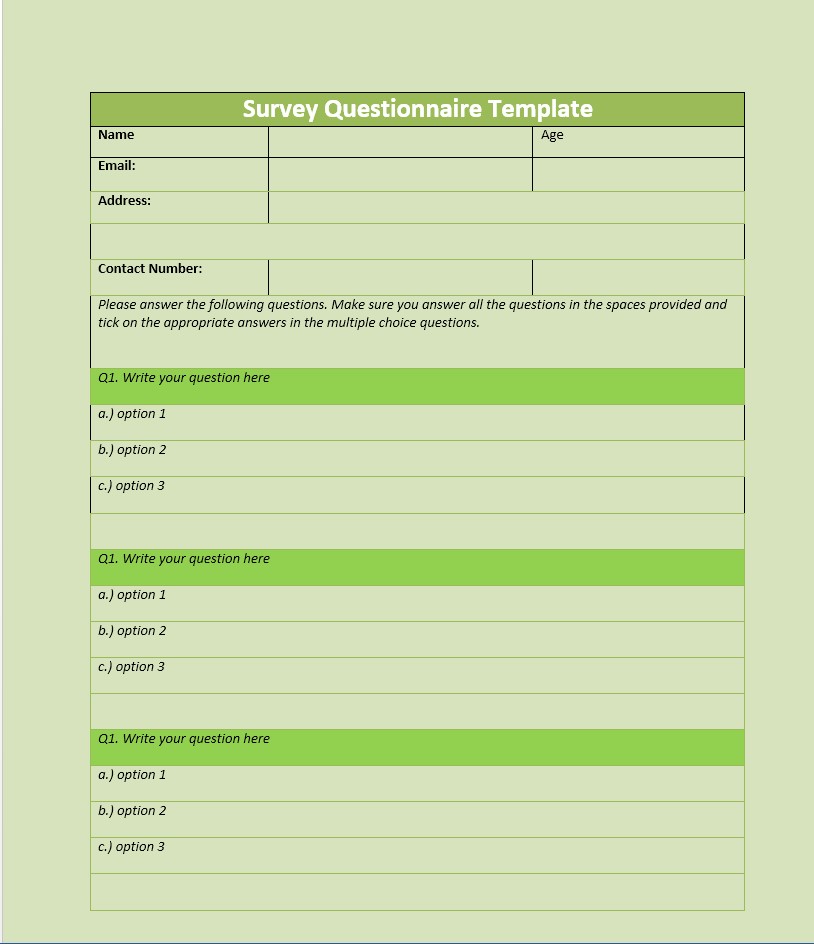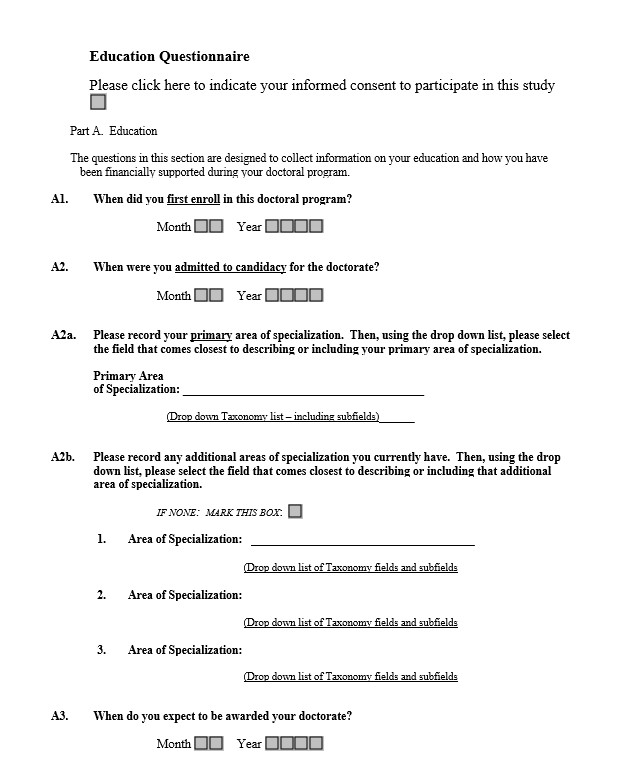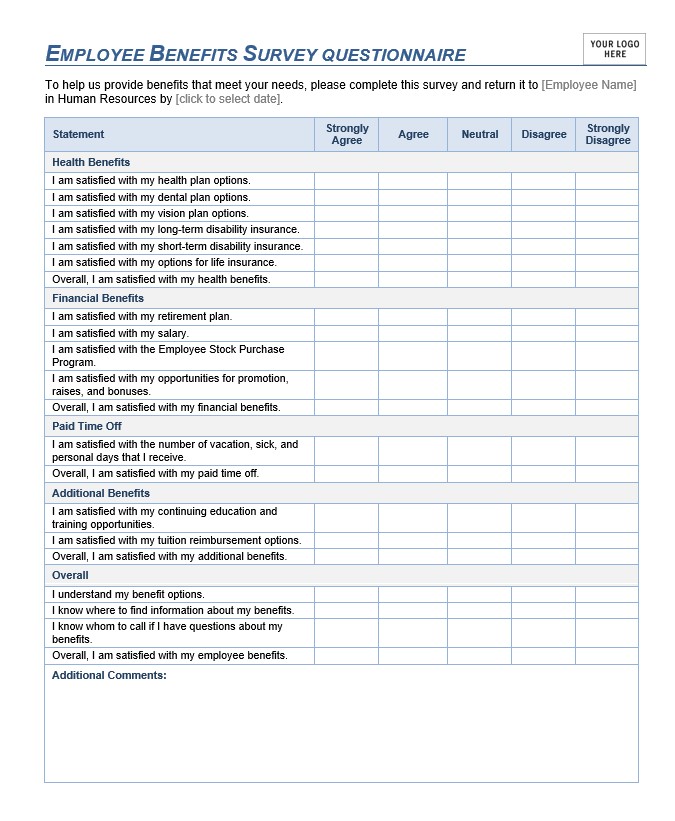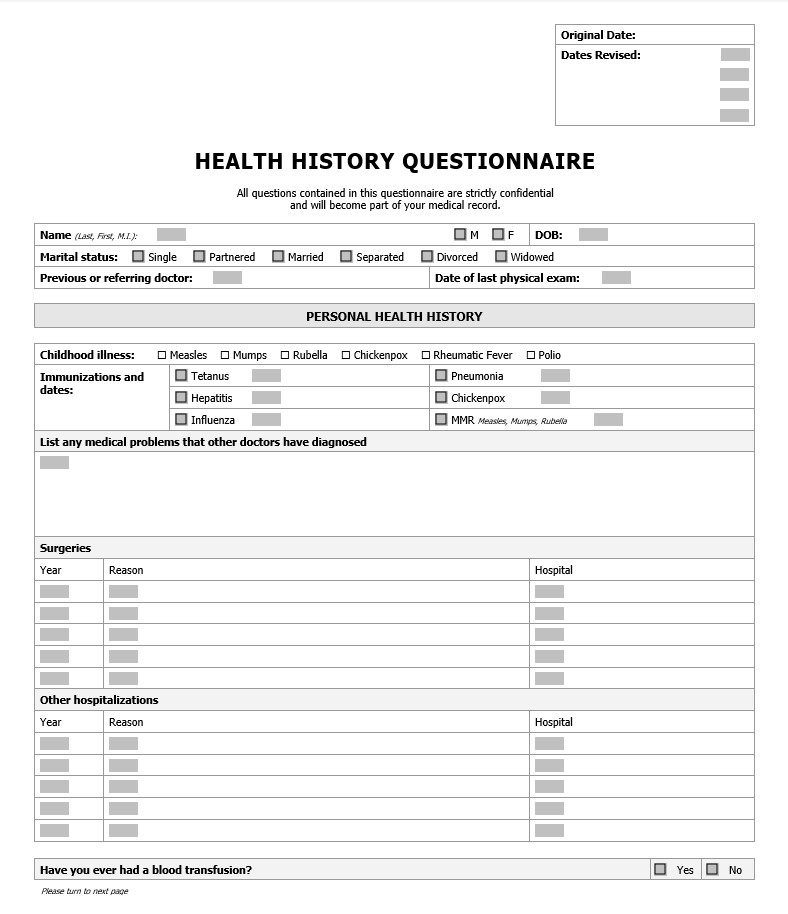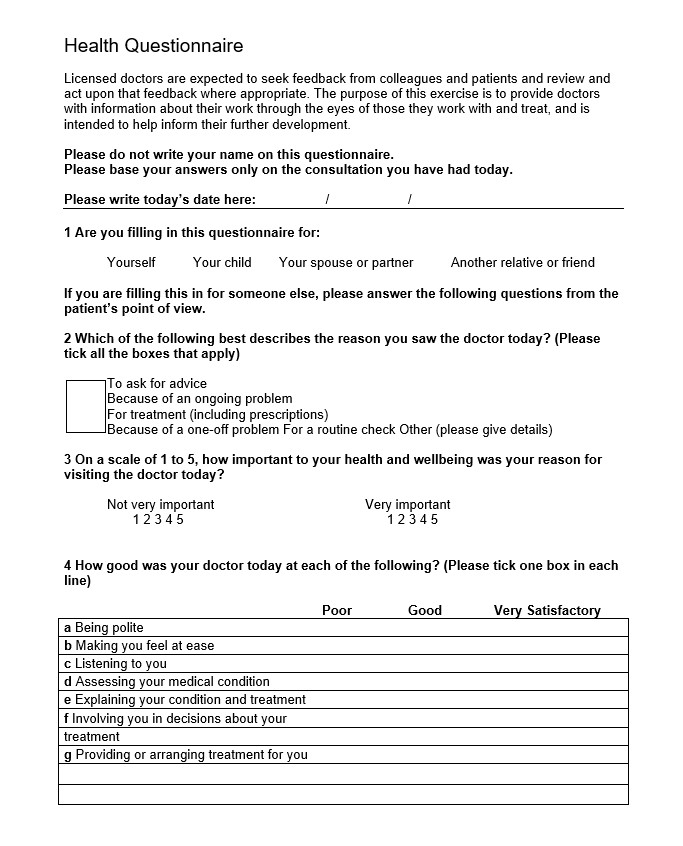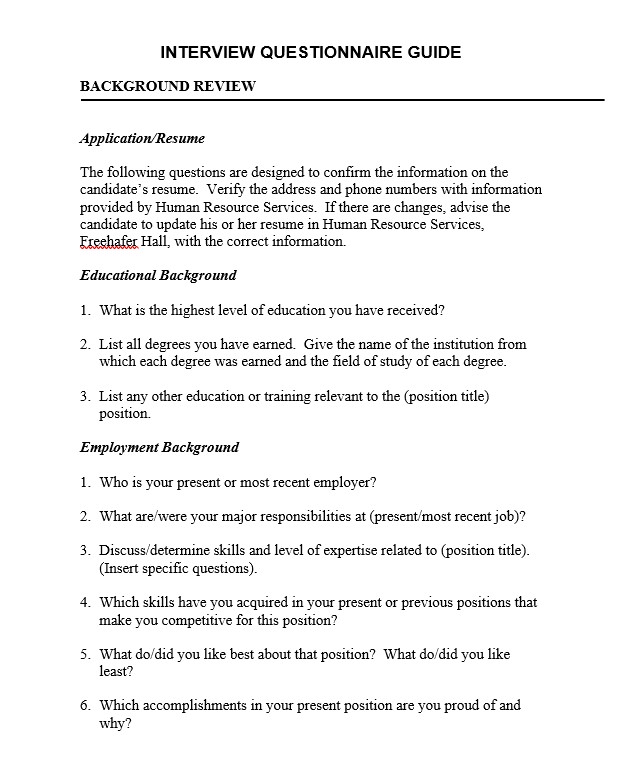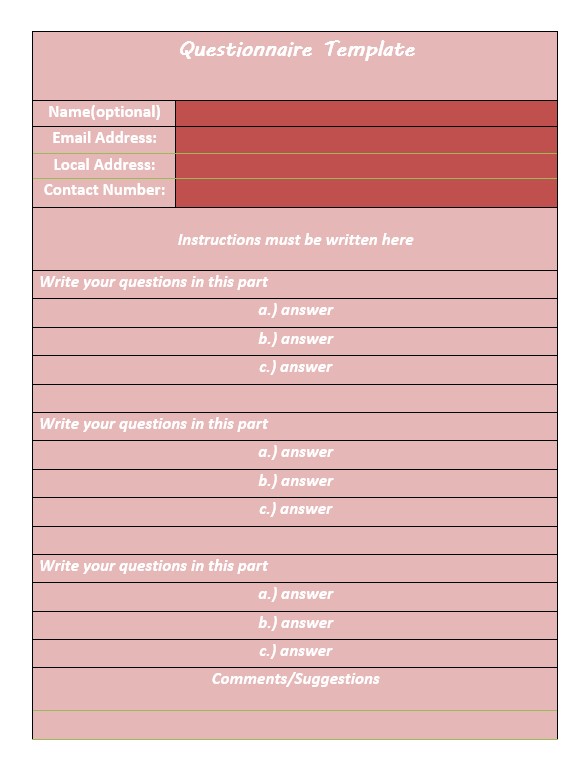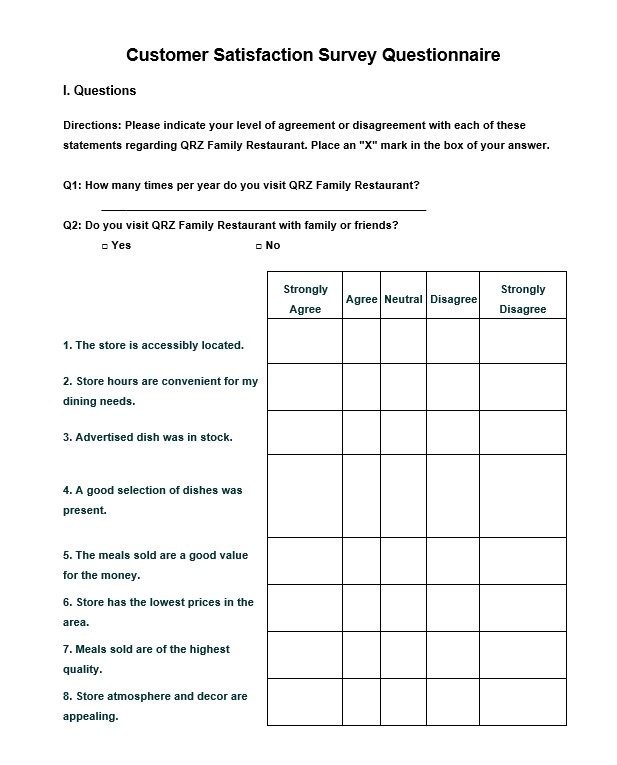Comprehensive Questionnaire Template to Boost Your Research – A questionnaire is an instrument to gather information that allows analysts to study the attitudes, beliefs, behaviors, and characteristics of the subjects. It contains a list of questions that must be filled in or answered by the respondent. Using the questionnaire, you can find out the circumstances or personal data related to the experience, knowledge, attitude, opinion etc. that we get from the respondent.
The purpose of preparing a questionnaire is to improve the parts that are not appropriate to be applied in the data collection of respondents. Respondents can easily provide answers because alternative answers have been provided – one example is the checklist-type questionnaire. In addition, the respondents will only need a short time to answer the questions in the questionnaire.
Types of Questionnaires
There are several distinct types of questionnaires, each with its unique characteristics and uses:
- Structured Questionnaires: Known as closed-ended questionnaires, these have pre-set questions and response options. The order of the questions is also pre-determined, providing respondents with a structured format to follow.
- Unstructured Questionnaires: These open-ended questionnaires allow respondents to express their thoughts in their own words. They are particularly useful for exploratory research that aims to gather qualitative data.
- Self-Administered Questionnaires: These questionnaires are completed by themselves. They can be handed out in person, sent by mail, or distributed electronically. They are especially useful when the target population is literate, and data can be collected at the respondent’s convenience.
- Interviewer-Administered Questionnaires: In this format, an interviewer reads the questions to the respondent and records their responses. This approach is beneficial when dealing with complex questions or when the respondent may have literacy challenges.
- Online Questionnaires: These questionnaires are distributed and completed online. They offer cost-effectiveness, the ability to reach a large audience swiftly, and automated data collection and analysis.
- Pictorial Questionnaires: These questionnaires use images to represent questions and responses, making them suitable for respondents who struggle with written or spoken language.
- Rating Scale Questionnaires: These questionnaires ask respondents to rate a specific issue on a fixed scale. For instance, a Likert scale might ask respondents to express their agreement with a statement on a scale from “strongly disagree” to “strongly agree.”
- Checklist Questionnaires: These questionnaires provide options and ask respondents to select all that apply to them.
The selection of the questionnaire type should be guided by the research objectives, the nature of the data needed, the characteristics of the target population, and the resources at hand.
Questionnaire Objectives
A questionnaire is a research instrument consisting of questions intended to gather information from respondents. The primary objectives of a questionnaire can vary based on the nature of the research but generally include the following:
- Data Collection: The primary objective of any questionnaire is to collect data on a particular subject. This data can be quantitative (numerical) or qualitative (descriptive), and it can provide valuable insights into the topic being studied.
- Understanding Perspectives: Questionnaires are often used to understand the respondents’ perspectives, opinions, and attitudes. They can help gauge public opinion on a particular issue, understand customer satisfaction, or gather employee feedback.
- Identifying Patterns and Trends: By collecting data from many respondents, questionnaires can help identify patterns and trends. It can be particularly useful in fields like market research, where understanding consumer behavior is crucial.
- Informing Decision-Making: The data collected through questionnaires can inform decision-making processes. For example, a business might use customer feedback to improve its products or services, or a government agency might use survey data to shape public policy.
- Testing Hypotheses: In academic or scientific research, questionnaires can be used to test hypotheses. The data collected can be analyzed to confirm or refute a proposed theory or assumption.
- Evaluating Programs or Interventions: Questionnaires can be used to evaluate the effectiveness of a program or intervention. For example, a questionnaire might measure the impact of a training program, a health intervention, or an educational curriculum.
Remember, a well-designed questionnaire aligns with its objectives. The questions should be carefully crafted to gather the necessary data to meet these objectives.
Characteristics of a Good Questionnaire
A questionnaire can be said as “good” enough if it meets the criteria below:
- Clear and Concise: The questionnaire should be as clear and concise as possible. Questions should be straightforward to understand. Avoid jargon, technical terms, or complex language that respondents might not understand.
- Relevant: Every question in the questionnaire should be relevant to the research objectives. Avoid including questions that do not directly contribute to your research goals.
- Unbiased and Neutral: It should not lead the respondent towards a particular answer. They should be neutral and unbiased to ensure the data collected is accurate and reliable.
- Logical Flow: It should be organized logically. It often means starting with public inquiries and gradually moving towards more specific ones. Similar or related inquiries should be grouped.
- Appropriate Response Options: If you use closed-ended questions, ensure the response options are complete and mutually exclusive. In other words, It should be able to find an opportunity that matches their answer, and each option should be distinct.
- Sensitive to Cultural and Social Differences: It should be sensitive to respondents’ cultural, social, and personal differences. Avoid questions that may be seen as offensive, intrusive, or inappropriate.
- Short and Time-Efficient: Respondents are likelier to complete a short questionnaire that takes little time. Long and time-consuming questionnaires can lead to respondent fatigue and lower response rates.
- Pre-Tested: It should be pre-tested or piloted on a small group of people. It helps identify any problems or misunderstandings with the questions before the questionnaire is distributed to a larger group.
The questionnaire design can significantly impact the data quality collected. It’s always a good idea to carefully design your questionnaire to ensure it meets these characteristics.
The examples of good questionnaire templates which meet those criteria can be seen and downloaded from this website. If you use the appropriate and good questionnaire template, you can get several advantages. The survey using a questionnaire does not require the presence of researchers or surveyors. A good questionnaire will make the respondent undoubtedly answer the questions, without being afraid or shy.
Questionnaire Template
Education Questionnaire
This type of questionnaire is used in education to gather information on various topics. It could be used to assess student satisfaction, evaluate teaching methods, understand the effectiveness of a curriculum, or gather feedback on school facilities. The questions are typically designed to gather insights from students, teachers, parents, or other stakeholders in the education process.
Employee Benefit Survey Questionnaire
This questionnaire is used by companies to understand how employees perceive their benefits package. It can help employers identify what benefits are most valued by employees, areas for improvement, and how their benefits package compares to industry standards. Questions cover health insurance, retirement plans, vacation time, and other perks.
Employee Health Questionnaire Template
This type of questionnaire is used to assess the health and wellness of employees. It can identify potential health risks, monitor the effectiveness of workplace wellness programs, and inform health and safety policies. Questions might cover physical activity, dietary habits, stress levels, and general health status.
Health Questionnaire Template
This general health questionnaire can be used in various settings, from doctor’s offices to health research studies. It typically includes questions about an individual’s medical history, lifestyle habits, and current health concerns or symptoms.
Interview Questionnaire Template
This type of questionnaire is used to guide interviews, whether they’re for research purposes, job interviews, or news reporting. The questions are designed to gather in-depth information from the interviewee on a specific topic.
Questionnaire Template Word
This general questionnaire template can be used for any purpose. It’s designed in Microsoft Word, making it easy to edit and customize to fit your needs. It can include any question, from multiple-choice to open-ended.
Customer Service Questionnaire Template
This questionnaire assesses the quality of a company’s customer service. It can help companies understand customer satisfaction, identify areas for improvement, and inform customer service training and policies. Questions cover response time, problem resolution, communication skills, and overall satisfaction.
Each of these templates serves a different purpose and can be a valuable tool for collecting data in various settings. Remember, the key to a successful questionnaire is to ensure it is well-designed, clear, and aligned with your research objectives.
What is the common mistake to avoid?
Avoiding common mistakes can help improve the quality of your questionnaire. Here are some key mistakes to avoid:
- Ambiguous or Vague Questions: Avoid using ambiguous or vague language in your questions. Be clear and specific to ensure that respondents understand what is being asked. Unclear questions can lead to confusion and inaccurate responses.
- Biased or Leading Questions: Be mindful of bias or leading language influencing respondents’ answers. Questions should be neutral and unbiased, allowing respondents to provide genuine opinions or experiences without being swayed by the question’s wording.
- Double-Barreled Questions: Double-barreled questions combine multiple questions into one, making it difficult for respondents to provide accurate responses. Each question should address a single concept or issue to avoid confusion and ensure meaningful answers.
- Order Effect Bias: The order in which questions are presented can influence respondents’ answers. Be cautious of the order effect bias, where previous questions may influence respondents’ answers. Consider randomizing or counterbalancing questions to minimize this bias.
- Overly Long or Complex Questions: Lengthy or complex questions can overwhelm respondents, leading to confusion and potential dropout rates. Keep questions concise and straightforward to maintain respondent engagement and ensure accurate responses.
- Insufficient Response Options: Ensure that closed-ended questions provide sufficient response options that cover the full range of possible answers. Failure to include appropriate response options may force respondents to choose an inaccurate or irrelevant option.
- Inadequate Instructions or Clarifications: Clear instructions and clarifications are essential for respondents to understand the questionnaire and provide accurate responses. Guide how to answer specific question types and any unique instructions related to the questionnaire.
- Lack of Pre-Testing or Pilot Testing: Skipping the step of pre-testing or pilot testing the questionnaire can result in unforeseen issues. Pre-testing allows you to identify and address problems with question clarity, length, or flow before distributing the questionnaire to a larger audience.
- Ignoring Respondent Fatigue: Long questionnaires or repetitive questioning can lead to respondent fatigue, resulting in decreased response quality or incomplete surveys. Keep the questionnaire length manageable and avoid unnecessary repetition to maintain respondent engagement.
- Failure to Consider Cultural or Language Differences: Ensure the questionnaire is culturally sensitive and language-appropriate for the target population. Be mindful of any cultural nuances, potential language barriers, or sensitivities that may affect the interpretation of questions or responses.
By avoiding these common mistakes, you can enhance the validity and reliability of your questionnaire, leading to more accurate and meaningful data collection. Remember to thoroughly review and revise your questionnaire before deployment, and consider seeking feedback from colleagues or experts in the field to ensure its effectiveness.
Advantages of Using a Good Questionnaire Template
A questionnaire template is a pre-designed survey or questionnaire with a set structure and format. Using a good questionnaire template can offer several advantages:
- Saves Time: One of the main advantages of using a questionnaire template is that it saves time. You don’t have to start from scratch, which can be particularly useful if you’re new to creating questionnaires or under time constraints.
- Standardization: A template ensures standardization, which is important if you’re conducting a large survey or if multiple people are involved in the data collection process. It ensures that everyone is using the same format and asking the same questions, which can improve the reliability of your results.
- Ease of Use: Most questionnaire templates are designed to be user-friendly. They often include instructions or guidelines on how to use them, which can be helpful for those who are less experienced with questionnaire design.
- Quality Assurance: Good questionnaire templates are typically designed by experts or professionals. It means they’re likely to follow best practices in questionnaire design, which can improve the quality of your data.
- Versatility: Many questionnaire templates can be adapted for various purposes. They often include a mix of question types (e.g., multiple choice, Likert scale, open-ended), which you can choose from based on your needs.
- Consistency: Using a template can help ensure consistency across multiple surveys or questionnaires. It can be particularly useful if you’re conducting a longitudinal study or want to compare data across different surveys.
- Reduced Errors: A well-designed template can help reduce errors in questionnaire design, such as leading questions, double-barreled questions, or unclear response options.=
Using a good questionnaire template can save time, ensure standardization and consistency, improve the quality of your data, and reduce errors. However, choosing a template that fits your needs and adapting it as necessary is important to ensure it aligns with your research objectives.

The content creator team at calipsotree.com is dedicated to making topics accessible to everyone, with over 9 years of experience in writing and breaking down complex concepts into easy-to-understand articles that answer readers’ financial questions.






